Anatomic organization of the basilar pontine projections from prefrontal cortices in rhesus monkey
- PMID: 8987769
- PMCID: PMC6793685
- DOI: 10.1523/JNEUROSCI.17-01-00438.1997
Anatomic organization of the basilar pontine projections from prefrontal cortices in rhesus monkey
Abstract
In our ongoing attempt to determine the anatomic substrates that could support a cerebellar contribution to cognitive processing, we investigated the prefrontal cortical projections to the basilar pons. A detailed understanding of these pathways is needed, because the prefrontal cortex is critical for a number of complex cognitive operations, and the corticopontine projection is the obligatory first step in the corticopontocerebellar circuit. Prefrontopontine connections were studied using the autoradiographic technique in rhesus monkey. The pontine projections were most prominent and occupied the greatest rostrocaudal extent of the pons when derived from the dorsolateral prefrontal convexity, including areas 8Ad, 9/46d, and 10. Lesser pontine projections were observed from the medial prefrontal convexity and area 45B in the inferior limb of the arcuate sulcus. In contrast, ventral prefrontal and orbitofrontal cortices did not demonstrate pontine projections. The prefrontopontine terminations were located preferentially in the paramedian nucleus and in the medial parts of the peripeduncular nucleus, but each cortical area appeared to have a unique complement of pontine nuclei with which it is connected. The existence of these corticopontine pathways from prefrontal areas concerned with multiple domains of higher-order processing is consistent with the hypothesis that the cerebellum is an essential node in the distributed corticosubcortical neural circuits subserving cognitive operations.
Figures
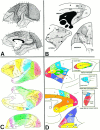

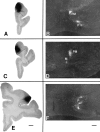

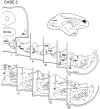

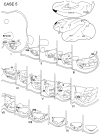
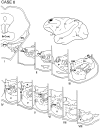

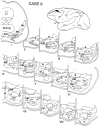
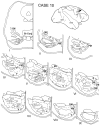
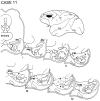


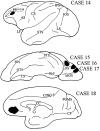

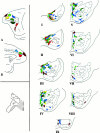
Similar articles
-
Prelunate, occipitotemporal, and parahippocampal projections to the basis pontis in rhesus monkey.J Comp Neurol. 1993 Nov 1;337(1):94-112. doi: 10.1002/cne.903370107. J Comp Neurol. 1993. PMID: 8276995
-
Anatomical investigation of projections to the basis pontis from posterior parietal association cortices in rhesus monkey.J Comp Neurol. 1989 Nov 1;289(1):53-73. doi: 10.1002/cne.902890105. J Comp Neurol. 1989. PMID: 2478597
-
Prefrontal cortex projections to the basilar pons in rhesus monkey: implications for the cerebellar contribution to higher function.Neurosci Lett. 1995 Oct 27;199(3):175-8. doi: 10.1016/0304-3940(95)12056-a. Neurosci Lett. 1995. PMID: 8577391
-
Organization of the pontine nuclei.Neurosci Res. 1992 Mar;13(2):83-118. doi: 10.1016/0168-0102(92)90092-q. Neurosci Res. 1992. PMID: 1374872 Review.
-
The basilar pontine nuclei and the nucleus reticularis tegmenti pontis subserve distinct cerebrocerebellar pathways.Prog Brain Res. 2005;148:259-82. doi: 10.1016/S0079-6123(04)48021-2. Prog Brain Res. 2005. PMID: 15661196 Review.
Cited by
-
Reduced Interhemispheric Coherence after Cerebellar Vermis Output Perturbation.Brain Sci. 2020 Sep 8;10(9):621. doi: 10.3390/brainsci10090621. Brain Sci. 2020. PMID: 32911623 Free PMC article.
-
Injury to the premature cerebellum: outcome is related to remote cortical development.Cereb Cortex. 2014 Mar;24(3):728-36. doi: 10.1093/cercor/bhs354. Epub 2012 Nov 11. Cereb Cortex. 2014. PMID: 23146968 Free PMC article.
-
Investigating individual differences in brain abnormalities in autism.Philos Trans R Soc Lond B Biol Sci. 2003 Feb 28;358(1430):405-13. doi: 10.1098/rstb.2002.1210. Philos Trans R Soc Lond B Biol Sci. 2003. PMID: 12639337 Free PMC article.
-
Activation of cerebellar hemispheres in spatial memorization of saccadic eye movements: an fMRI study.Hum Brain Mapp. 2004 Jun;22(2):155-64. doi: 10.1002/hbm.20025. Hum Brain Mapp. 2004. PMID: 15108303 Free PMC article.
-
Evidence of corticofugal tau spreading in patients with frontotemporal dementia.Acta Neuropathol. 2020 Jan;139(1):27-43. doi: 10.1007/s00401-019-02075-z. Epub 2019 Sep 21. Acta Neuropathol. 2020. PMID: 31542807 Free PMC article.
References
-
- Aas J-E, Brodal P. Demonstration of topographically organized projections from the hypothalamus to the pontine nuclei: an experimental study in the cat. J Comp Neurol. 1988;268:313–328. - PubMed
-
- Anand BK, Malhotra CL, Singh B, Dua S. Cerebellar projections to the limbic system. J Neurophysiol. 1959;22:451–458. - PubMed
-
- Astruc J. Corticofugal connections of area 8 (frontal eye field) in Macaca mulatta. Brain Res. 1971;33:241–256. - PubMed
-
- Bachevalier JB, Mishkin M. Visual recognition impairment follows ventromedial but not dorsolateral prefrontal lesions in monkeys. Behav Brain Res. 1986;20:249–261. - PubMed
-
- Barbas H, Mesulam M-M. Cortical afferent input to the principalis region of the rhesus monkey. Neuroscience. 1985;15:619–637. - PubMed
Publication types
MeSH terms
Grants and funding
LinkOut - more resources
Full Text Sources
